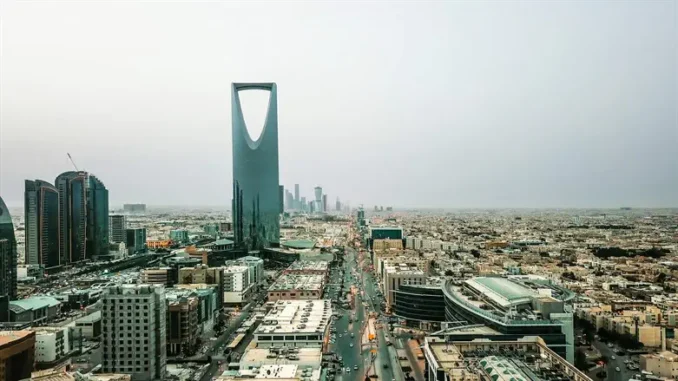The are doing that by destabilizing Saudi Arabia which is already frustrated by the US State Department’s attitude towards Iran.
 Aerial view of Riyadh, Saudi Arabia iStock< strong>
Aerial view of Riyadh, Saudi Arabia iStock< strong>
Ambassador (ret.) Yoram Ettinger is author of “Second Thought: a US-Israel Initiative” bit.ly/4dzWi9V
Since the February 1979 Ayatollahs’ Islamic Revolution – which transformed Iran from “America’s policeman in the Gulf” to the epicenter of anti-US terrorism – Iran’s Islamic Revolutionary Guard Corps (IRGC) has attempted to erode the US strategic posture, regionally and globally, including Latin America. Thus, the IRGC has agitated and radicalized the Shiite communities in the pro-US, oil-producing, Sunni Arab countries, while training Shiite terrorists and providing them weapons and explosives. The IRGC has focussed on Bahrain and Saudi Arabia (Bahrain’s patron), and especially on Saudi Arabia’s Eastern Province, which is the home of the bulk of Saudi oil reserves, as well as, the main Saudi refinery and export terminal of Ras Tanura, where the Shiites – who are a 20% minority in Saudi Arabia – constitute a majority. Moreover, the Ayatollahs claim title to the major offshore Al-Durra oil and natural gas field, currently controlled by Saudi Arabia and Kuwait.
The Saudi perception of Iran’s Ayatollahs
*The Saudi Crown Prince, Muhammed bin Salman (MBS), the de facto ruler of the kingdom, does not allow the March 2023 resumption of the Saudi-Iranian diplomatic ties to smother the reality of the inherently subversive, terroristic, anti-Sunni and imperialistic track record of Iran’s Ayatollahs. MBS is cognizant of the fact that the Ayatollahs’ 1,400-year-old Shiite ideology – as stipulated in their 1979 Constitution, school curriculum, mosque sermons, and documented in their systematic rogue policy – mandates the toppling of all pro-US, oil-producing, “heretic” Sunni regimes, especially Saudi Arabia, which controls Mecca and Medina, the two holiest Moslem sites, and rivals the Ayatollahs for the dominance of the Moslem World and the Persian Gulf.
*He is aware that Saudi Arabia is a top prize for the Ayatollahs, since it constitutes the chief component of the Persian Gulf’s 48% of global oil and natural gas reserves, a focal point of global economy, in general, and the price at the pump, in particular. Furthermore, toppling the pro-US Saudi regime would accord the anti-US Ayatollahs control of the Arabian Peninsula, which dominates much of the shipping route between Europe and the Far East.
*The Saudi Crown Prince does not allow the State Department’s alternate reality to befog the Middle East reality of tenuous and shifty regimes – which do not ascend to power through the ballot, but through the “bullet” – and therefore yield tenuous and shifty policies and agreements.
*Thus, the March 2023 Saudi-Iranian diplomatic agreement was not the first resumption of Saudi-Iranian diplomatic ties, which were previously severed in 1988 and 2016, and followed by the Ayatollahs-induced domestic and regional violence.
*Saudi Arabia is cognizant of the fanatic, religious vision of the Ayatollahs, which requires the exportation the Shiite Islamic Revolution, regionally and globally. They are aware that neither diplomatic, nor financial, short-term benefits showered by the West upon the Ayatollahs transcend the deeply-rooted, long-term Ayatollahs’ vision of toppling the “apostate” Sunni regimes and bringing to submission “The Great American Satan.”
*While the State Department is engrossed with the smooth Ayatollahs’talk, which cushioned the 2015 JCPOA and the March 2023 diplomatic agreement, the Saudi Crown Prince is preoccupied with the rogue Ayatollahs’ walk in the Persian Gulf, Yemen, Iraq, Syria, Jordan, Lebanon, the Horn of Africa, north and west Africa and Latin America. This is demonstrated by the Ayatollahs’ track record of anti-US terrorism, drug trafficking, money laundering and the proliferation of military systems to anti-US entities.
*The Saudi Crown Prince is aware that the 14-centuries-old divide between the Sunnis (85% of the world Moslem population) and the Shiites (15%) has fueled Middle East conflicts, domestically (e.g., Lebanon, Syria, Iraq and Yemen) and regionally (e.g., Iraq-Iran, Saudi Arabia-Iran). It has threatened the survival of all pro-US, oil-producing, Sunni Gulf countries (e.g., Saudi Arabia, the United Arab Emirates, Kuwait, Bahrain), especially since the February 1979 Shiite Islamic Revolution, which transformed Iran from a pro-US stabilizing force in the Gulf to an anti-US destabilizing force, regionally and globally, exporting the Islamic Revolution, and expanding its strategic foothold all the way to Latin America – the soft underbelly of the US – threatening the US homeland security.
*The Saudi Crown Prince (MBS), the UAE ruler (MBZ) and all other pro-US Arab leaders are frustrated by the 45-year-old State Department’s self-destructive diplomatic option toward Iran, which has yielded a robust tailwind to the Ayatollahs’ anti-US and anti-Sunni strategy. They are perplexed by the State Department’s non-realization that Iran’s Ayatollahs are the head of the venomous anti-US global octopus, not partners to negotiation, but a critical target for regime-change.



Are the US intel using Iran to get rid of Trump!
Yoram Ettinger has accurately summarized the views of MBS and the other Gulf State Arab states concerning the U.S administration’s pro-Iranian, anti-Gulf State, and above all anti-Israel tilt. That tilt is having a devastating impact on America’s standing in the Middle East.